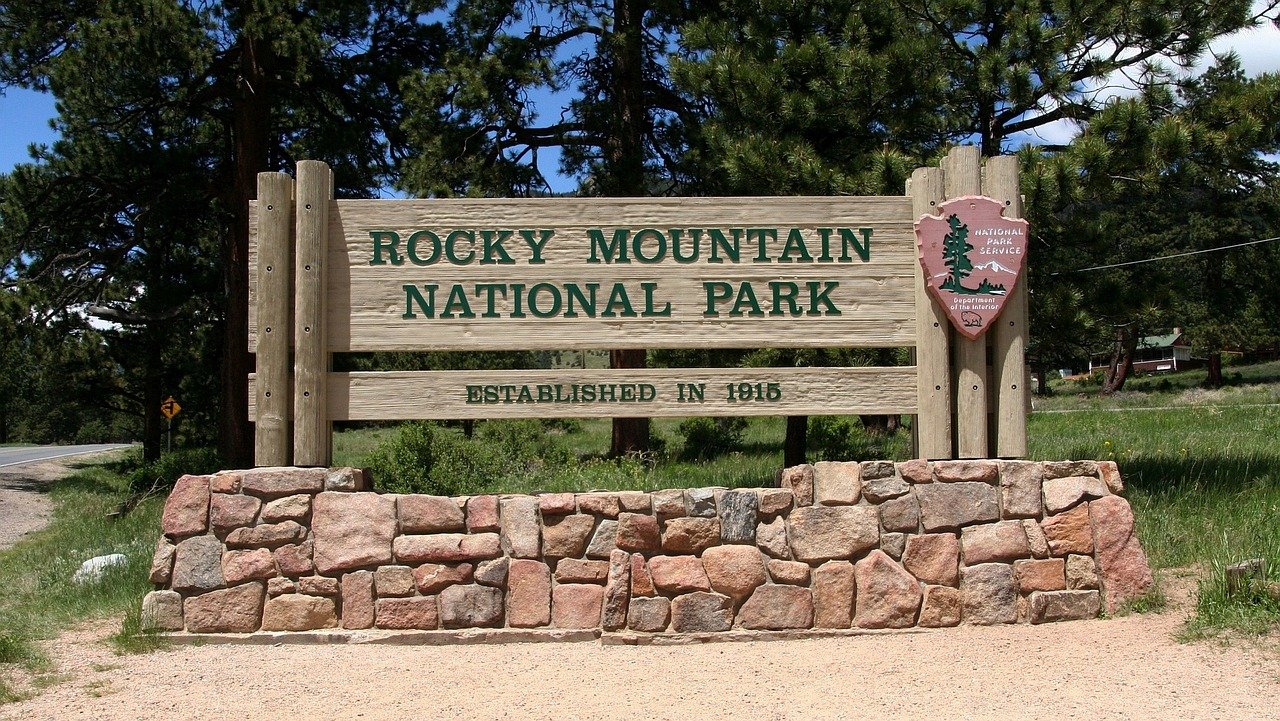Introduction to RockY Mountain National Park
Rock Mountain National Park, located in the US state of Colorado, is one of the most beautiful and scenic parks in the world. The park is an important part of the US National Parks system and is extremely popular with tourists due to its high mountains, deep valleys, lush forests, and various lakes.
Geographical location of the
RockY Mountain National
park
Rock Mountain National Park is ocated in the north-central part of the state of Colorado. The park covers an area of about 415 square miles, including more than 60 high mountains, some of which are over 14,000 feet high. The park’s geography makes it rich in climatic and biological diversity, and it contains several ecological zones, including alpine tundra, montane forests, and steppes.
The reason for the importance and popularity of the park
There are several reasons for the importance and popularity of Rocky Mountain National Park. The natural landscapes here, such as towering mountains, deep forests, and picturesque lakes, make it a paradise for nature lovers. The park’s diverse wildlife, including deer, elk, black bear, and mountain goats, are a special attraction for visitors.
Additionally, Rock Mountain National Park’s numerous hiking trails, camping sites, and photography spots also attract tourists. The Trail Ridge Road in the park, located at an elevation of over 12,000 feet, is one of the highest paved roads in the world and is a major tourist attraction.
The importance of the park is not only due to its natural beauty and recreational opportunities, but also its environmental protection and natural heritage are world-renowned. Various measures have been taken to preserve the landscape and biodiversity, which helps in maintaining the beauty of the park for future generations.

Historical Background
The history of the Rock Mountain National Park region spans thousands of years, including the presence of Native American tribes, the arrival of European tourists, and the eventual establishment of the park. This historical background is essential to understand the current status of the park and its importance.
Ancient History of the Rock Mountain Region
The Rock Mountain National Parkarea has been home to humans for thousands of years. According to the oldest evidence, there is evidence of human presence in the area around 11,000 years ago. These ancient people were hunters and gatherers, who changed their habitats according to the seasons. Despite the region’s harsh climate and difficult geography, these people took full advantage of the natural resources here.

History and Heritage of Native American Tribes
Several Native American tribes livedin the Rock Mountain area, including the Ute, Shoshone, and Arapaho tribes. These tribes depended on the natural resources here and adapted their lifestyles to the characteristics of the area. The people of these tribes not only hunted but also used forest fruits, herbs and other resources.
The Ute tribe was particularly attached to the area and its cultural legacy is still present in the area today. Ancient Native American art and archeological remains are found throughout the park, testifying to how these tribes lived here.
The arrival of European tourists in the 19th century
European tourists and adventurers visited the area in the early 19th century. The arrival of these tourists marked a new turning point in the history of the region. In 1803, after the Louisiana Purchase, American explorers and tourists flocked to the area. In the 1820s, famous explorer Stephen Long surveyed Rock Mountain, providing the first detailed information on the area.
With the arrival of European tourists, the search for natural resources, such as gold and furs, had a profound effect on the lives of the local tribes. Due to the touristic interest and the beauty of the area, the fame of the mountain scenery increased, and the area became an attraction for more tourists.

Movement to establish park
In the late 19th and early 20th centuries, the national parks movement in the United States gained momentum. People realized the need to preserve natural landscapes and wildlife. The movement to establish Rock Mountain National Park also started during this period.
Among the founders of the International Park Movement were well-known naturalists such as John Muir, who raised their voice for the preservation of natural beauty. In 1909, a local man named Enos Mills began a formal campaign to establish Rock Mountain National Park. He made people aware of the natural and ecological importance of the park and promoted the movement at the government level as well.
Finally, in 1915, the US Congress approved the creation of Rock Mountain National Park, and on January 26, 1915, it was officially established. The park has been an important center for natural scenery, wildlife, and environmental conservation ever since.
The history of Rock Mountain National Park teaches us how humans struggled to preserve this natural heritage and today the park is a priceless treasure for tourists not only in the United States but around the world.
Establishment of Rock Mountain National Park
The creation of Rock Mountain National Park was a long and arduous process, made possible by several key figures and events. The establishment of this park was not only to preserve the natural beauty, but it was also a reflection of the growing environmental awareness and public demand in America at that time.
Establishment of National Park
The creation of Rock Mountain National Park began in the late 19th century, when America’s awareness of the preservation of natural landscapes and wildlife arose. In the late 19th century, Coloradoans and tourists were drawn to the beauty and natural resources of the Rock Mountain region. The area had become famous for its natural beauty and scenery, and people felt the need to preserve it.
In 1909, a naturalist named Enos Mills started a campaign to make the area a national park. He was an adventurer, writer, and nature lover himself and spent much of his life in the Rock Mountain region. Nineteen Peaks understood the importance of this park and raised its voice for its protection.
Important personalities and events that contributed to the establishment of the park
The efforts of Nineteen Peaks spurred the movement to establish a national park. Through his books, lectures, and articles, he made people aware of the natural importance of the Rock Mountain region. His movement gained attention not only from the local people but also at the national level.
Besides Nineteen Peaks, naturalists like John Muir also supported this movement. John Mayer, one of the founders of America’s National Parks movement, made significant contributions to the preservation of natural landscapes. He spoke about the beauty of Rock Mountain and its ecological importance on various occasions to gain public support.
In 1914, the movement gained momentum when US President Woodrow Wilson signed a bill establishing Rock Mountain National Park. By this time, the work of Nineteen Peaks and other experts had made the importance of establishing a park clear, and public opinion was in favor of it.
Regular establishment of the park in 1915
On January 26, 1915, the US Congress formally authorized the establishment of Rock Mountain National Park, and the park became part of the US National Park System. At that time the area of the park was about 358 square miles, which later increased to 415 square miles.
After the park was established, the area quickly became a tourist attraction. Its beautiful scenery, towering mountains, and diverse wildlife began to attract tourists from all over the world. After the establishment of the park, the government took various measures to protect its natural heritage, including securing the park boundaries, protecting wildlife, and conserving the flora and fauna of the park.
The hard work and determination of Nine Peaks and other naturalists played a fundamental role in the establishment of this park. Today, Rock Mountain National Park is an example of a natural heritage for people not only in the United States, but around the world, as a reminder of how important it is to maintain natural beauty and ecological balance.
Significance of Rock Mountain National Park
Rock Mountain National Park is known not only for its natural beauty and biodiversity, but also for its ecological importance, its impact on tourism, and the historical and cultural sites it contains. The park protects the natural heritage as well as benefits the local economy and tourism industry.
Natural Landscapes and Biodiversity
The main feature of Rock Mountain National Park is its natural scenery. The park features towering mountains, lush valleys, sparkling lakes, and breathtaking waterfalls that make it a paradise for nature lovers. The park includes about 60 high mountains, of which Longs Peak is the highest.
The biodiversity of the park is also unparalleled. There are different ecological zones, including alpine tundra, mountain forests, and steppes. Due to this diversity, different types of plants and animals are found in the park. Forests here include trees such as pine, spruce, and fir, while animals include elk, mountain lion, black bear, and goats.
Environmental importance of the park
The ecological significance of Rock Mountain National Park is also extremely important. The park’s alpine tundra, located at an elevation of more than 11,000 feet, is one of the rarest ecosystems in the world. This system is very sensitive and it is important to protect the flora and fauna here from environmental changes.
The park’s lakes and rivers are also important for ecological balance. These are important water bodies that are important not only for the life inside the park but also for the areas outside the park. In addition, the park’s various ecological zones provide an important location for ecological research and education.
Impact of Park on Tourism and Local Economy
Rock Mountain National Park is an important tourist destination. Every year millions of tourists come to see the beauty of the park. This tourism not only boosts the local economy but also boosts various businesses, such as hotels, restaurants, and recreational activities.
Tourism provides employment opportunities to local people and local industries also develop. Various tourism activities in the park, such as hiking, camping, and photography, attract tourists, helping to stabilize the local economy.
Historical and Cultural Sites in the Park
Rock Mountain National Park has not only natural beauty but also historical and cultural sites of importance. Various sites in the park contain traces of the history and heritage of Native American tribes, giving a glimpse into their culture and way of life.
Historic sites such as the Nineteen Peaks cabin also commemorate the park’s history. Nineteen Peaks used this cabin during their stay and the site holds an important place in the park’s history. Other historic sites in the park, such as ancient adventurers’ trails and camping sites, also highlight the park’s cultural heritage.
—
These various significances of Rock Mountain National Park make it an important natural heritage not only for the United States but also for the world. All these features of natural scenery, biodiversity, ecological importance, tourism, and historical heritage combine to make this park a unique place.

Present status and future of the park
The current situation of Rock Mountain National Park is a reflection that efforts to maintain and protect the park are important, but there are also various challenges. Various plans and initiatives are being taken to address these challenges and preserve the park for the future.
Maintenance and protection of the park in present day
Currently, the National Park Service (NPS) plays an important role in the maintenance and protection of Rock Mountain National Park. Various programs are underway in the park to protect natural resources, such as forests, lakes, and biodiversity. Under these programs, park staff are trained and use advanced technology to conserve natural resources.
Park maintenance also includes systematic management of tourism activities. Infrastructure is being improved in various parts of the park for tourists to enjoy the natural scenery and not harm the environment of the park. In addition, measures are being taken to limit the number of tourists and control access to certain areas to protect the park’s critical ecological zones.
Challenges of Park Conservation
There are many challenges in the conservation of the park, among which climate change is the biggest challenge. Global warming is causing the park’s temperature to rise, affecting the park’s alpine tundra and wildlife. The rate of melting of ice is increasing, affecting water bodies and endangering plants and animals.
Another major challenge is the growing number of tourists. The large number of tourists is putting pressure on the park’s natural resources. Trails and camping sites are becoming increasingly difficult to maintain, and the risk of damage to the natural environment from careless tourists is also increasing.
A third challenge is illegal activities, such as poaching, deforestation, and illegal trade in rare plants. These activities harm the ecological balance of the park and hinder the protection of natural heritage.

Plans and Actions for the Future
Various plans and initiatives are being taken in the future to ensure the safety and sustainability of the park. Chief among these are measures to combat climate change. The National Park Service has emphasized the use of renewable energy to reduce carbon emissions. In addition, construction of new reservoirs and rehabilitation of old reservoirs are being planned to protect water resources in the park.
Plans are also being made to manage tourism in the park. Measures are being taken to improve the infrastructure at tourist spots as well as limit the number of tourists. In addition, advanced technology will be used to monitor the ecological zones in the park to ensure their safety.
Future plans are also being made to prevent illegal activities in the park. These plans include increasing cooperation with law enforcement agencies and better training park staff. In addition, programs are being initiated to involve the local community in the protection of the park so that they can play their role in protecting the park.
—
These initiatives and projects are essential to ensure the safety and sustainability of Rock Mountain National Park. Although the park faces various challenges, the National Park Service’s efforts and plans will help preserve this natural heritage well into the future.
result
The overall significance of Rock Mountain National Park is summarized in terms of its natural beauty, biodiversity, historical and cultural heritage, and environmental protection. The park is a valuable natural heritage for people not only in the United States but around the world, highlighting the importance of ecological balance and conservation of natural resources.
Rock Mountain National Park’s natural scenery, including towering mountains, lush valleys, and crystal-clear lakes, attracts tourists from around the world. The biodiversity here, including various rare species of plants and animals, makes the park an important ecological site.
The park’s historical and cultural heritage, reminiscent of Native American tribes and European adventurers, adds to its historical significance. The historical sites and archaeological sites in the park not only keep its history alive but also highlight its cultural heritage.
Rock Mountain National Park has a unique place in the world because it is an example of protecting natural heritage and maintaining ecological balance. Efforts to protect this park and future plans ensure that this natural treasure will be preserved for generations to come. The future of the park, despite its current situation and challenges, is promising and will continue to be an important ecological and tourist destination for people around the world.
—
The significance of Rock Mountain National Park lies not only in its natural scenery and biodiversity, but also in its historical, cultural and environmental heritage. Efforts made for its conservation and sustainability give this park a unique place in the world.

Pingback: best hikes in rocky mountain national park - National Parks Aroun The World
I am really inspired with your writing talents as well as with the format for
your weblog. Is that this a paid subject matter or did
you customize it your self? Anyway keep up the nice quality
writing, it is uncommon to look a nice weblog like
this one nowadays. Blaze AI!
Get ready to elevate your betting experience with an exclusive 1xBet promo code! Whether you’re from Bangladesh, Pakistan, India, Nepal, Sri Lanka, Nigeria, Egypt, or the Philippines, you can unlock amazing rewards like free bets, no deposit bonuses, and free spins using the latest 1xBet promo codes today. New users can enjoy a special registration promo code that boosts your first deposit or even gives you a chance to play risk-free. Looking for a Bangladesh 1xBet promo code or a 1xBet promo code India for the app? We’ve got it all here, updated daily. Don’t miss your chance to grab a 1xBet official promo code, win big, and make the most out of your betting journey. Claim your 1xBet free promo code today and start winning smarter with bigger bonuses, free spins, and more exclusive offers worldwide! No matter where you are, finding the right 1xBet promo code today means unlocking bigger chances to win, with offers perfectly tailored for players across Bangladesh, Pakistan, India, Nepal, Sri Lanka, Nigeria, Egypt, and the Philippines.
Can you be more specific about the content of your article? After reading it, I still have some doubts. Hope you can help me.
Can you be more specific about the content of your article? After reading it, I still have some doubts. Hope you can help me.
I don’t think the title of your article matches the content lol. Just kidding, mainly because I had some doubts after reading the article.
Can you be more specific about the content of your article? After reading it, I still have some doubts. Hope you can help me.
Your article helped me a lot, is there any more related content? Thanks!